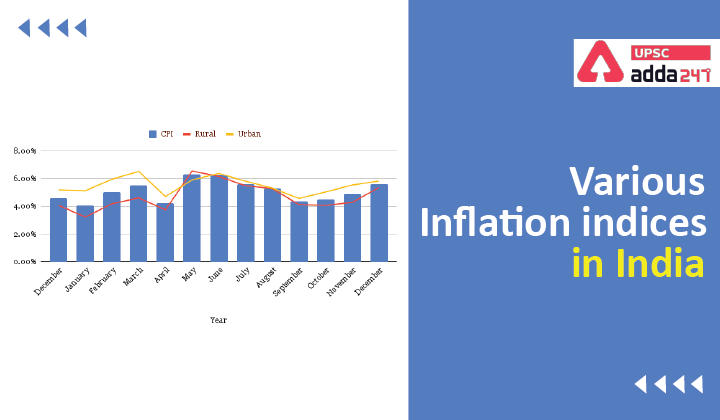Table of Contents
In our previous article, we discuss in detail the concept of inflation in India. Inflation is a very important topic for UPSC IAS exam. The topic inflation is important not only because direct questions are asked from the topic, but also because reading newspapers like The Hindu becomes difficult if you don’t understand some of the basic terms of economy like inflation.
Before going into the various indices of inflation, let us first quickly revise what is inflation?
Inflation is an economic term describing the sustained increase in prices of goods and services within a period.
We have seen in our previous article that depending upon the ‘level’ where price of goods is calculated, there are three types of inflation:
To calculate inflation at these three levels, we need different methodology to measure inflation at each level distinctively.
Producer Price Index
- PPI is a measure of inflation from the perspective of producers.
- Generally, Producer Price Index measures the average change in the prices of both goods and services over a certain period of time.
- It may be calculated either as they leave the place of production or as they enter the input production process. While the former is called output PPI, the latter is called input PPI.
- They exclude any taxes, transport and trade margins that the purchaser may have to pay.
- PPI is considered as a better measure of inflation because the price change at the primary and intermediate stage can be tracked before it is transferred into finished good stage.

Wholesale Price Index
- Wholesale price index (WPI) measures and tracks the changes in the price of goods in the stages before the retail level.
- It means WPI measures those goods that are sold in bulk and traded between entities or businesses (instead of between consumers).
- Base Year: 2011-12.
- The commodities in the WPI basket are categorised into three groups
| Group | Weightage |
| Manufactured Products | 64% |
| Primary Articles | 23% |
| Fuel & Power | 13% |
Calculation of WPI
- WPI is calculated based on the Geometric Mean of the commodities.
- Office of Economic Adviser, Department of Industrial Policy and Promotion, Ministry of Commerce and Industry compiles and release WPI.
WPI importance
- WPI measures inflation at the wholesale level and thus helps in timely intervention by the govt before the price increase impact the retail prices.
- Global investors also decide their investment by tracking indicators like WPI.
WPI limitation
- One of the major limitations of WPI is that it does not include services.
- Also, the exclusion of indirect taxes in WPI could not give true picture of the price of commodity, even at wholesale level.
Consumer Price Index
- The Consumer Price Index measures the average change in prices over time that consumers pay for a basket of goods and services.
- So, CPI measures average change in the prices at the consumer level.
- In India, we use CPI as an indicator to measure inflation for the formulation of monetary policy.
- Base year: 2012.
CPI calculation
- CPI is calculated by CSO (Central Statistics Office), Ministry of Statistics and Programme Implementation.
- We calculate 4 different sets of inflation. They are given below.
Types of CPI
CPI-IW (Industrial Worker)
- It measures the change in the prices of the commodity basket consumed by the industrial worker.
- Government uses this index for computing wage in organised sectors.
- Base Year: 2001
- It is compiled and released by Labour Bureau, Ministry of Labour.
CPI-UNME (Urban Non-Manual Employees)
- It measures the change in the prices of the commodity basket consumed by the Non-Manual Employees.
- It was published by CSO.
- It has been discontinued.
CPI-AL (Agricultural Labourers)
- It measures the change in the prices of the commodity basket consumed by the agricultural labourers.
- It is used for revising Minimum wage for the Agricultural Labourers.
- Base Year: 1986-87
- It is compiled and released by Labour Bureau, Ministry of Labour.
CPI-RL (Rural Labourers)
- It measures the change in the prices of the commodity basket consumed by the Rural Labourers like rural artisans, cottage industry workers etc.
- It is used for revising Minimum wage for the rural labourers.
- Base Year: 1986-87
- It is compiled and released by Labour Bureau, Ministry of Labour.
CPI revision in 2011
- In 2011, the government announced a new CPI as the previous one could not give a nationwide picture. The new CPI comprises of two indices—CPI-Rural and CPI-Urban.
CPI-Rural
- Base year: 2012
- It is calculated by CSO.
CPI-Urban
- Base year: 2012
- It is calculated by CSO.
GDP deflator
- GDP deflator is the ratio of the value of goods and services an economy produces in a particular year at current prices to that of prices that prevailed during the base year.
- Since the deflator covers the entire range of goods and services produced in the economy, it is seen as a more comprehensive measure of inflation.
- GDP deflator measures the difference between real GDP and nominal GDP.
- The formula to find the GDP price deflator:
- GDP price deflator = (nominal GDP ÷ real GDP) x 100
Also Read:




 TSPSC Group 1 Question Paper 2024, Downl...
TSPSC Group 1 Question Paper 2024, Downl...
 TSPSC Group 1 Answer key 2024 Out, Downl...
TSPSC Group 1 Answer key 2024 Out, Downl...
 UPSC Prelims 2024 Question Paper, Downlo...
UPSC Prelims 2024 Question Paper, Downlo...
